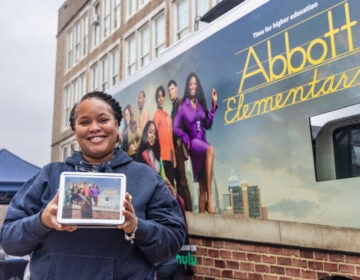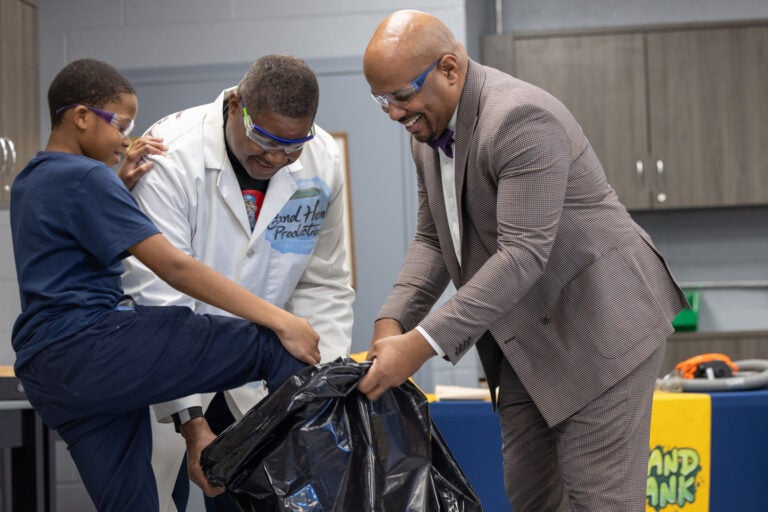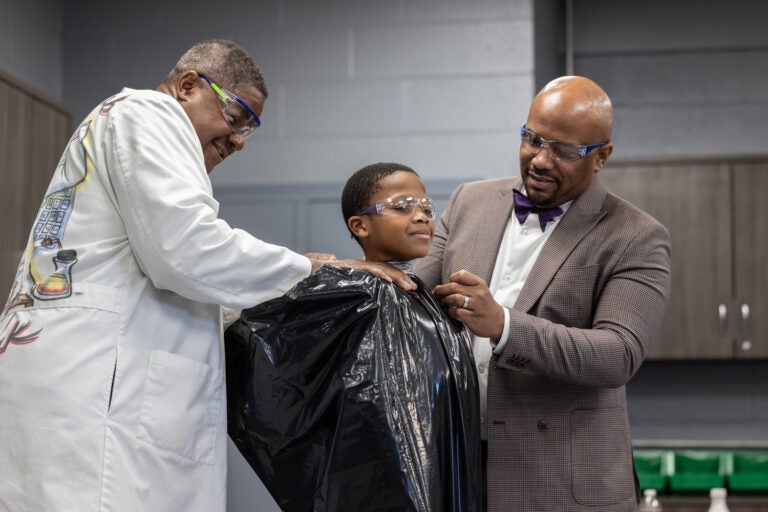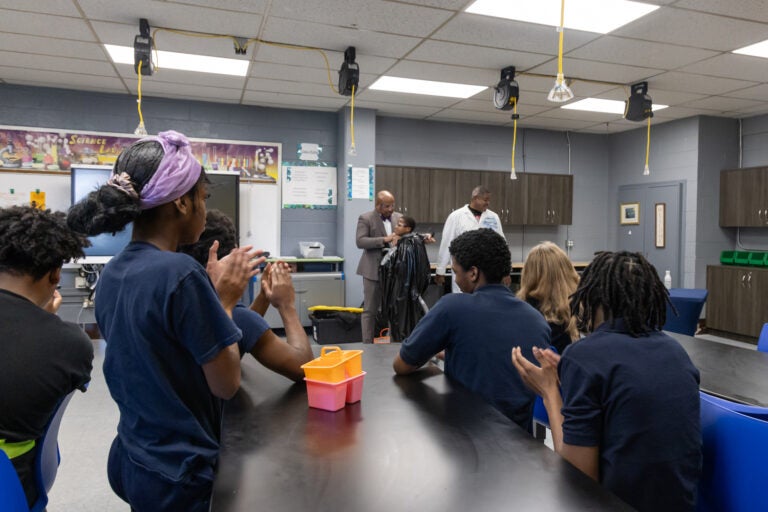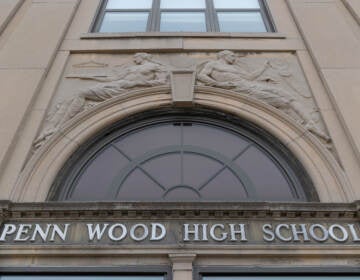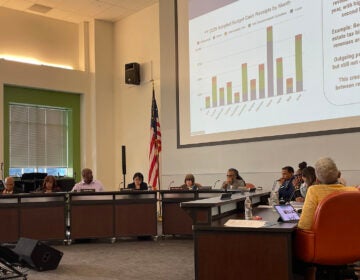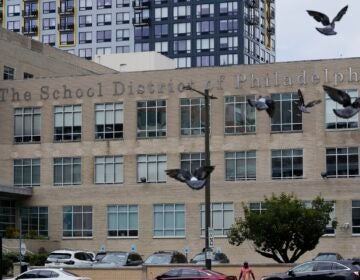Scientist ‘Grand Hank’ inspires Philly students to delve deeper into the world of STEM careers
On Tuesday at Allen M. Stearne School in Philly, eighth grade students were in awe as "Grand Hank" demonstrated different cool and innovative explanations of science.
Listen 1:30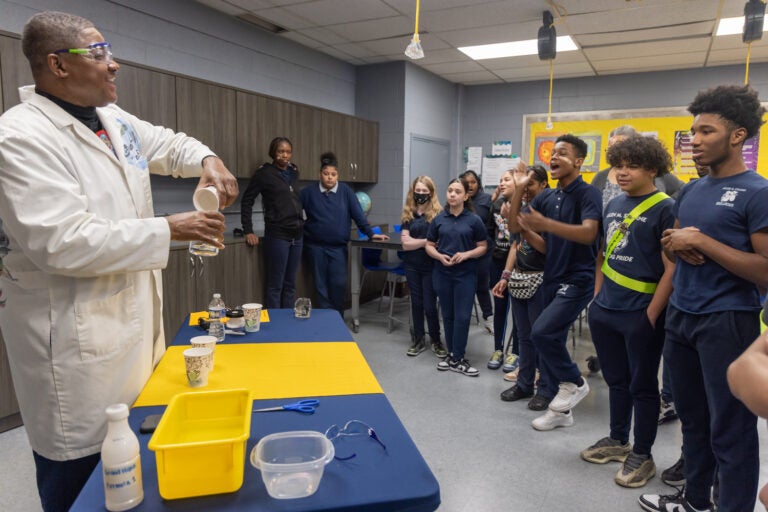
Tyraine Ragsdale, aka Grand Hank (left), challenges 8th grade students’ perception during an interactive science demonstration at the Allen M. Stearne middle school in Philadelphia on February 6, 2024. (Kimberly Paynter/WHYY)
From Philly and the Pa. suburbs to South Jersey and Delaware, what would you like WHYY News to cover? Let us know!
Tyraine Ragsdale, affectionately known as the “Master Scientist Grand Hank,” is once again sharing his love of science and math with local students.
“I had a vision for this, that if we could just get to the masses and demonstrate to them up close and personal, so they can see, you can do this too. I’ve done it and I’m here to show you, you can do it,” said Ragsdale.
A former research chemist for Johnson & Johnson, Ragsdale founded Grand Hank Productions, Incorporated, a multimedia education company, in 1989.
Ragsdale, who said he grew up poor in Philly’s public housing, was motivated by a teacher in the district to pursue college and become a scientist. He now shares his story and his love of STEM through fun, hands-on learning workshops.
Ragsdale’s story stands as a living reminder that anything is possible; the scientist has had a profound impact on STEM education, reaching more than 10 million students, parents and teachers globally.
On Tuesday at Allen M. Stearne School in Philly, eighth grade students were in awe as Ragsdale demonstrated different cool and innovative explanations of science.
Eighth-grade student Khasir Phillips volunteered for one science experiment where Ragsdale said he would pull blood from the anxious student’s hand.
But it’s not what you think. There wasn’t any real blood, but Ragsdale asked Phillips to place his hand in a bowl, and while he counted down students began murmuring as Ragsdale warned students that Phillips’ hand would come out of the bowl, bloody.
“How does your hand feel,” Hank asked Phillips.
Phillips nervously replied, “It feels weird but a good kind of weird,” before telling the crowd he felt something happening to his hand.
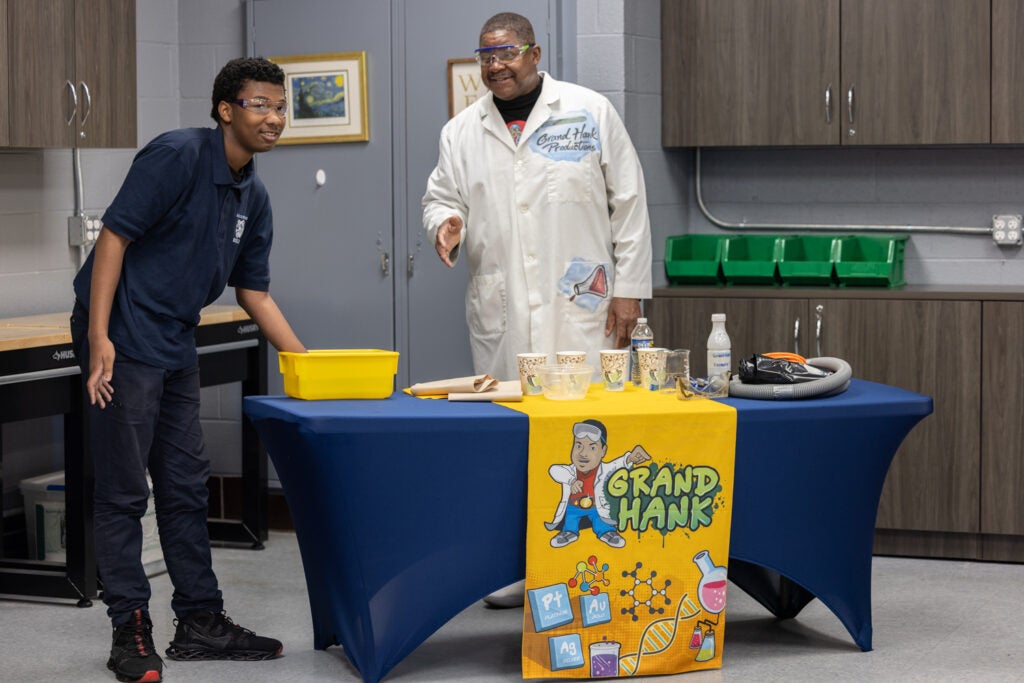
A few moments later Ragsdale pulled Phillips’ hand out of the bowl and wiped it on a piece of paper, where red markings appeared.
The room of more than two dozen 8th-grade students erupted in “oooohs and ahhhhs” while Ragsdale wiped off Phillips’ hand and simply shared, “That’s how science works.”
This is just one example of how Ragsdale engages young people in the School District of Philadelphia using cool real-life demonstrations to teach them about subjects that otherwise would be considered boring for some.
“It’s different from normal types of science. We don’t just sit down and learn something but instead you go participate and do something fun that interests you that’s why people start to like science more and more,” said Phillips.
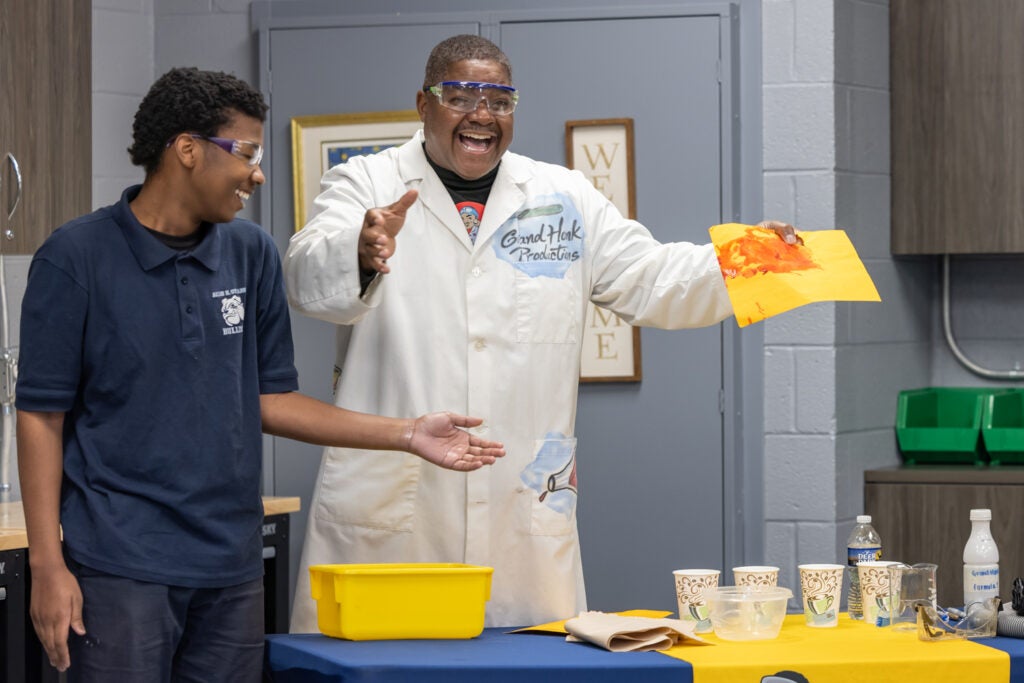
According to the district, nationally women constitute 50% of the college-educated workforce but comprise only 28% of the science and engineering workforce. Black/African Americans, Hispanics, and Native Americans make up 11% of workers in science and engineering occupations.
To improve these outcomes workshops like this matter.
School District of Philadelphia Chief of Curriculum and Instruction Nyshawana Francis-Thompson, aka Dr. Ny, says the district wants to change the trajectory and increase the number of students entering the field of STEM.
“We know that there is a particular underrepresentation of Black and brown students as well as women represented in the STEM field,” said Francis-Thompson.
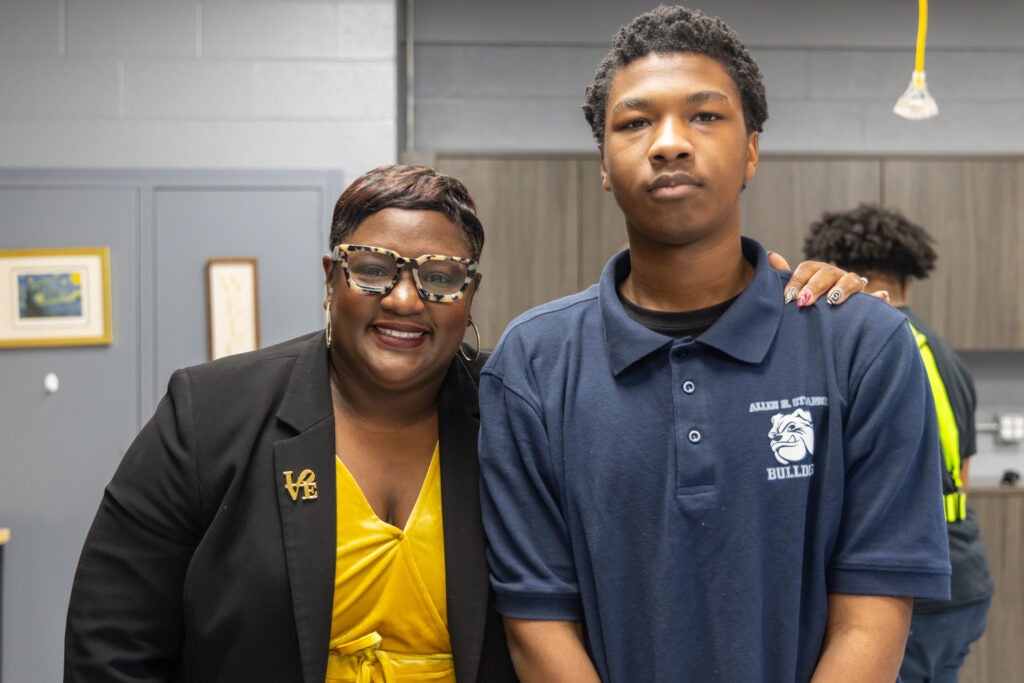
Francis-Thompson said that underrepresentation is hurting the industry.
“We know that it’s less than 20% represented in those careers so we want to open up those pathways for our young people. We know they deserve it and we can do it,” she said.
And it’s working — Phillips first saw “Grand Hank” in action when he was in seventh grade, in a similar classroom setting. Phillips said that’s when he knew he wanted to pursue a career in engineering.
“I had an affinity for robots, but this really did push me to be more of an engineer,” said Phillips.
Black professionals only make up 9% of STEM workers in the United States according to Science News. Phillips said those numbers don’t discourage him.
“As a Black man, I feel like we should learn more. And not be discouraged by our color,” said Phillips.
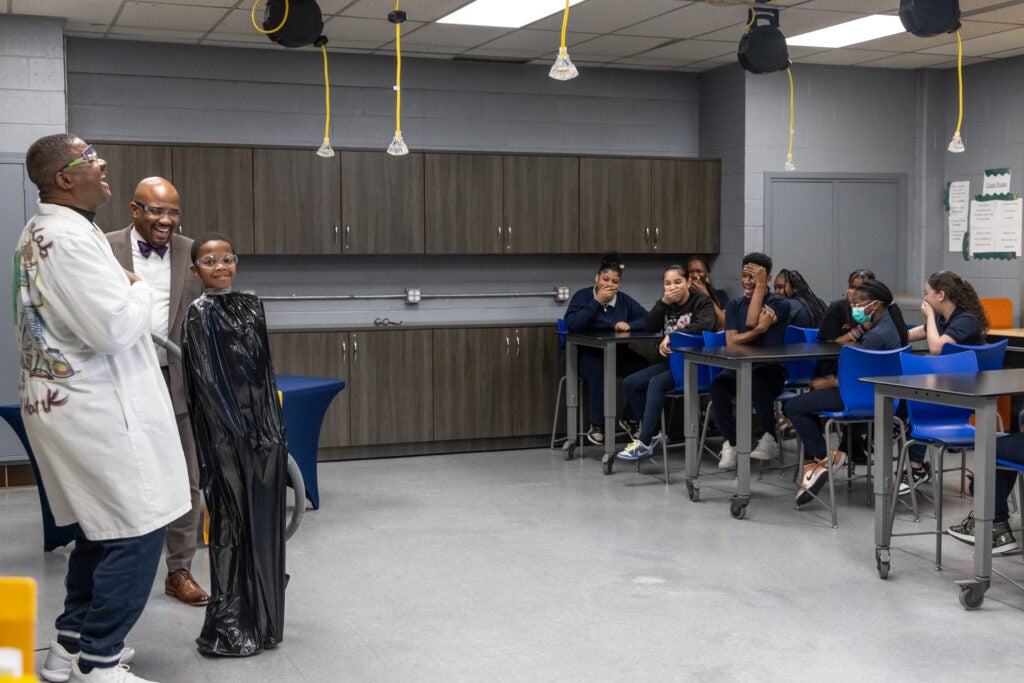
Thanks to funding from the district, the classroom where “Grand Hank” did his demonstration at Allen M. Stearne School has been remodeled to provide a maker’s room for their students.
“I think it’s important that the neighborhood school gets a win,” said Principal Alphonso Evans, who shared that his students will now be able to have a space at the school for more full-time STEM-related learning and projects.
Evans says it’s a way to introduce students in North Philly to subjects they may have never considered in the past.
“I don’t think that parents need to send their children miles and miles away for them to get a phenomenal education and be exposed to what they deserve,” said Evans.
The goal is also to open a new pathway for students to pursue STEM-related professions.
The School District plans to continue these types of lessons for more students by utilizing “The Philadelphia STEM Equity Collective” for a $10 million program to increase diversity in students pursuing STEM Careers.
Ragsdale said he will soon put his show on the road. The Grand Hank’s 16th Annual Mega Black History STEM Field Trip will invite students in K-8th grade to celebrate African American scientists and inventors through live STEM demonstrations set to music. There will also be a night session for families and students. The event will be February 27-28 at The Met in Philadelphia.
In the future, Ragsdale hopes to be able to also provide his lessons full-time with a center made just for students and STEM-related activities.
Ragsdale has begun renovations and construction of the new Grand Hank STEM Center for Inner City Youth. The venue, located adjacent to LaSalle University in Philadelphia, will be a place any student can go to work on their math and science exploration and skills. Ragsdale said he has raised more than $1 million and hopes to be able to raise an additional $200,000 to complete the project and open the center for area youth.
“The ultimate goal is to build a pipeline of a thousand scientists, in the next three to five years; that’s the ultimate goal,” said Ragsdale.

Get daily updates from WHYY News!
WHYY is your source for fact-based, in-depth journalism and information. As a nonprofit organization, we rely on financial support from readers like you. Please give today.


